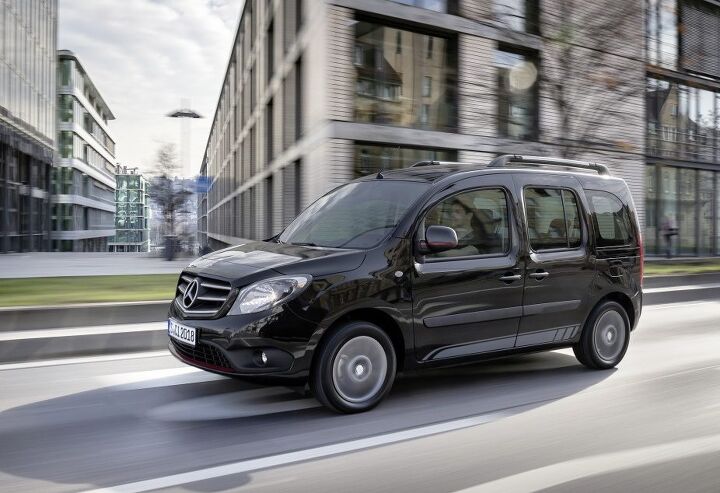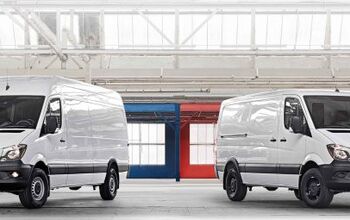More Van News From Mercedes-Benz

Despite vans being slightly more popular than getting a thumb in the eye, Mercedes-Benz is sticking with them. Earlier in the month, the automaker revealed the production version of its 252-mile (we’ll see) EQV. Essentially an electrified version of the plush V-Class/Metris, the model will likely serve a very specific subset of the population.
On the other end of the spectrum, Daimler has been mulling over what should be done about the Citan. As the smallest van in MB’s range, the Citan also has the lowest point of entry. However, sales are roughly one-sixth what the V-Class sees in Europe, making it a plausible candidate for discontinuation. But it was not to be. On Friday, Daimler announced it will keep its smallest MPV on the table.
“The new Citan will undergo a comprehensive new development and clearly be recognisable [sic] as a Mercedes-Benz at first glance. We will provide for a distinctive brand-adequate identity in the successor of our small van,” explained Marcus Breitschwerdt, head of Mercedes-Benz Vans.
If the phrase “brand-adequate identity” left you flummoxed, we’ll explain. The current Citan is technically a rebadged Renault Kangoo II. The duo even share an assembly line in France. Breitschwerdt’s wording is a reminder that this will carry over when it comes time to build a successor.
Is it wise? Well, Daimler has already received some criticism that the Citan doesn’t improve on the Kangoo enough to warrant its substantially higher price tag — something that’s reflected in Renault’s larger sales numbers. Other rebadged vehicles from the Renault-Nissan-Mitsubishi Alliance have also bitten MB in the past. Reengineering Nissan’s Navara into the Mercedes-Benz X-Class pickup was clearly a mistake. Despite putting quite a bit behind the model’s launch, the truck has been underperforming and is reportedly being considered for termination. There are even rumors that Mercedes’ leadership plans on dissolving the partnership by simply not renewing commitments.
That places an asterisk beside the next-gen Citan’s product announcement. If Daimler seriously wants it built, it may have to buy more time with Renault. But the only upside we see from the partnership is more jobs for Nissan’s powertrain plant in Decherd, Tennessee and Mercedes getting a steady supply of entry-level motors… many of which are too small to be a hit in North America. The Citan isn’t likely to grace our shores, either.
That makes the story here less about getting you throttled up for a van you’ll probably never consider buying and more about assessing Mercedes-Benz Vans’ current business strategy. Daimler is positioning itself for some hefty restructuring, with layoffs estimated to surpass 10,000. That makes it slightly odd to see the brand announce a new model with ties to Renault when a core aspect of the plan was rumored to involve cutting those business ties.
It’s a tad confusing. But Mercedes claims the new Citan is en route, so we’ll stick with that for now. Renault’s Kangaroo III is believed to enter production late in 2020, meaning we probably have until then to see if Daimler changes its mind. Details on the vehicles are minimal, with the only confirmation being both vans will come with (small) internal-combustion powertrains and at least one electrified variant.
[Image: Daimler AG]

A staunch consumer advocate tracking industry trends and regulation. Before joining TTAC, Matt spent a decade working for marketing and research firms based in NYC. Clients included several of the world’s largest automakers, global tire brands, and aftermarket part suppliers. Dissatisfied with the corporate world and resentful of having to wear suits everyday, he pivoted to writing about cars. Since then, that man has become an ardent supporter of the right-to-repair movement, been interviewed on the auto industry by national radio broadcasts, driven more rental cars than anyone ever should, participated in amateur rallying events, and received the requisite minimum training as sanctioned by the SCCA. Handy with a wrench, Matt grew up surrounded by Detroit auto workers and managed to get a pizza delivery job before he was legally eligible. He later found himself driving box trucks through Manhattan, guaranteeing future sympathy for actual truckers. He continues to conduct research pertaining to the automotive sector as an independent contractor and has since moved back to his native Michigan, closer to where the cars are born. A contrarian, Matt claims to prefer understeer — stating that front and all-wheel drive vehicles cater best to his driving style.
More by Matt Posky
Latest Car Reviews
Read moreLatest Product Reviews
Read moreRecent Comments
- ToolGuy This thing here is interesting.For example, I can select "Historical" and "EV stock" and "Cars" and "USA" and see how many BEVs and PHEVs were on U.S. roads from 2010 to 2023."EV stock share" is also interesting. Or perhaps you prefer "EV sales share".If you are in the U.S., whatever you do, do not select "World" in the 'Region' dropdown. It might blow your small insular mind. 😉
- ToolGuy This podcast was pretty interesting. I listened to it this morning, and now I am commenting. Listened to the podcast, now commenting on the podcast. See how this works? LOL.
- VoGhost If you want this to succeed, enlarge the battery and make the vehicle in Spartanburg so you buyers get the $7,500 discount.
- Jeff Look at the the 65 and 66 Pontiacs some of the most beautiful and well made Pontiacs. 66 Olds Toronado and 67 Cadillac Eldorado were beautiful as well. Mercury had some really nice looking cars during the 60s as well. The 69 thru 72 Grand Prix were nice along with the first generation of Monte Carlo 70 thru 72. Midsize GM cars were nice as well.The 69s were still good but the cheapening started in 68. Even the 70s GMs were good but fit and finish took a dive especially the interiors with more plastics and more shared interiors.
- Proud2BUnion I typically recommend that no matter what make or model you purchase used, just assure that is HAS a prior salvage/rebuilt title. Best "Bang for your buck"!


































Comments
Join the conversation
The Citan is mainly sold to businesses which already make use of other Mercedes-Benz products such as the Sprinter, Vito, Axor, Actros, Econic and so forth. All of these vehicles can be easily serviced at the next Mercedes-Benz dealership which makes this an easier affair than if the business had bought the Renault Kangoo on which this is based. My brother runs a taxi business and I believe has one or two Citans in his fleet which have been converted to handle disabled customers and their wheelchairs. Along with the V-Klasse/Vito, that is a good purpose for these cars.
I realize that North America has spat out every small passenger MPV that the world has tried to bless it with. But I'd like to be one of the five weirdos in America who'd buy a Renault Kangoo with a highly improbable three-pointed star on the snoot.